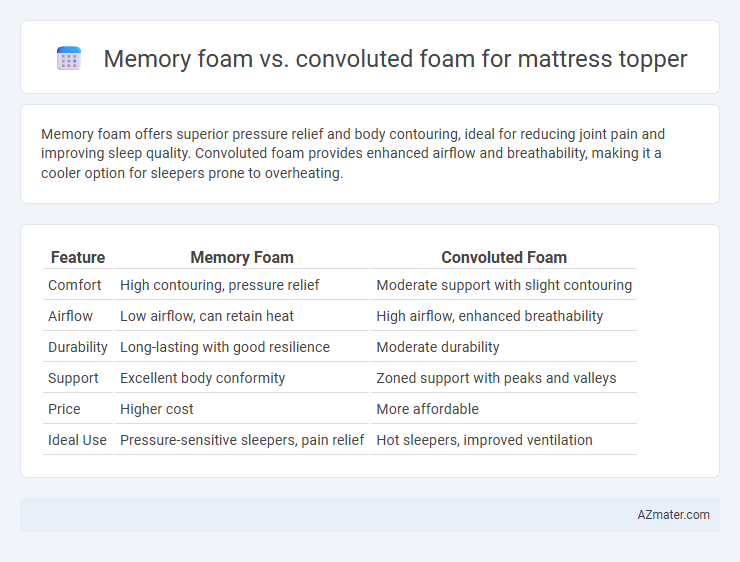Memory foam offers superior pressure relief and body contouring, ideal for reducing joint pain and improving sleep quality. Convoluted foam provides enhanced airflow and breathability, making it a cooler option for sleepers prone to overheating.
Table of Comparison
| Feature | Memory Foam | Convoluted Foam |
|---|---|---|
| Comfort | High contouring, pressure relief | Moderate support with slight contouring |
| Airflow | Low airflow, can retain heat | High airflow, enhanced breathability |
| Durability | Long-lasting with good resilience | Moderate durability |
| Support | Excellent body conformity | Zoned support with peaks and valleys |
| Price | Higher cost | More affordable |
| Ideal Use | Pressure-sensitive sleepers, pain relief | Hot sleepers, improved ventilation |
Introduction to Mattress Toppers: Memory Foam vs Convoluted Foam
Memory foam mattress toppers conform closely to the body's contours, providing targeted pressure relief and enhanced support through viscoelastic properties. Convoluted foam toppers feature an egg-crate design that promotes airflow, improving breathability and offering a gentler cushioning effect. Choosing between memory foam and convoluted foam depends on preferences for support level, temperature regulation, and overall sleep comfort.
What Is Memory Foam? Features and Benefits
Memory foam is a viscoelastic material known for its high density and responsiveness, offering superior contouring support by evenly distributing body weight and reducing pressure points. Its temperature-sensitive properties allow it to soften with heat, adapting to individual body shapes for personalized comfort and enhanced spinal alignment. Memory foam mattress toppers provide benefits such as motion isolation, durability, and relief from joint pain, making them ideal for those seeking therapeutic sleep solutions.
Understanding Convoluted Foam: Egg Crate Design Explained
Convoluted foam, commonly known as egg crate foam, features a distinctive egg crate design with peaks and valleys that enhance airflow and promote breathability, reducing heat retention during sleep. This open-cell structure provides targeted pressure relief by distributing body weight evenly, which can alleviate pressure points and improve comfort. Compared to solid memory foam, convoluted foam offers a lighter, more ventilated option that balances support with cooling properties, making it ideal for sleepers prone to overheating.
Comfort and Support Comparison
Memory foam mattress toppers conform to body contours, providing excellent pressure relief and support for spinal alignment. Convoluted foam offers enhanced airflow through its egg-crate design, promoting breathability and moderate cushioning but with less contouring ability. Choosing between memory foam and convoluted foam depends on whether personalized comfort or increased ventilation is the priority for mattress enhancement.
Pressure Relief: Which Foam Performs Better?
Memory foam excels in pressure relief by conforming closely to body contours, distributing weight evenly and reducing pressure points, especially around hips and shoulders. Convoluted foam, with its egg-crate design, enhances airflow and provides moderate pressure relief by alleviating localized stress but lacks the deep contouring ability of memory foam. For superior pressure redistribution and comfort, memory foam generally outperforms convoluted foam in mattress toppers.
Durability and Longevity: Memory Foam vs Convoluted Foam
Memory foam mattresses offer superior durability due to their dense structure, maintaining shape and support for 7 to 10 years with consistent use. Convoluted foam, designed with a peak-and-valley surface for enhanced breathability, typically lasts around 3 to 5 years before showing signs of wear and compression. Choosing memory foam mattress toppers ensures longer-lasting comfort and resilience compared to convoluted foam options.
Heat Retention and Breathability: Differences Analyzed
Memory foam mattress toppers are known for excellent contouring and pressure relief but tend to retain heat due to their dense cellular structure, leading to reduced breathability. Convoluted foam, featuring an egg-crate design, enhances airflow and breathability, effectively dissipating heat and providing a cooler sleeping surface. Choosing between the two depends on individual heat sensitivity, with convoluted foam offering superior temperature regulation compared to traditional memory foam.
Allergy Concerns and Hypoallergenic Properties
Memory foam mattress toppers are made from viscoelastic polyurethane that is naturally resistant to dust mites and allergens due to its dense structure, making it a preferred choice for allergy sufferers. Convoluted foam, with its egg-crate design, promotes airflow and moisture-wicking, which helps reduce mold and mildew growth but may trap more allergens if not properly maintained. Both materials offer hypoallergenic benefits; however, memory foam's inherent resistance to common allergens provides superior protection for individuals with respiratory sensitivities.
Cost Comparison: Memory Foam vs Convoluted Foam Mattress Toppers
Memory foam mattress toppers typically cost more than convoluted foam due to their dense viscoelastic properties that offer superior pressure relief and contouring. Convoluted foam toppers are more budget-friendly, providing adequate airflow and moderate cushioning but less durability and support compared to memory foam. Consumers seeking long-term investment in comfort and spinal alignment often find memory foam worth the higher price, while cost-conscious buyers prefer convoluted foam for temporary or supplementary use.
Which Mattress Topper Is Right for You?
Memory foam mattress toppers conform closely to your body, providing pressure relief and motion isolation, ideal for side sleepers or those with joint pain. Convoluted foam toppers offer increased airflow and a lighter, more breathable option, suitable for hot sleepers seeking enhanced ventilation. Choosing the right mattress topper depends on your sleep position, temperature preferences, and desired firmness level.

Infographic: Memory foam vs Convoluted foam for Mattress topper
 azmater.com
azmater.com